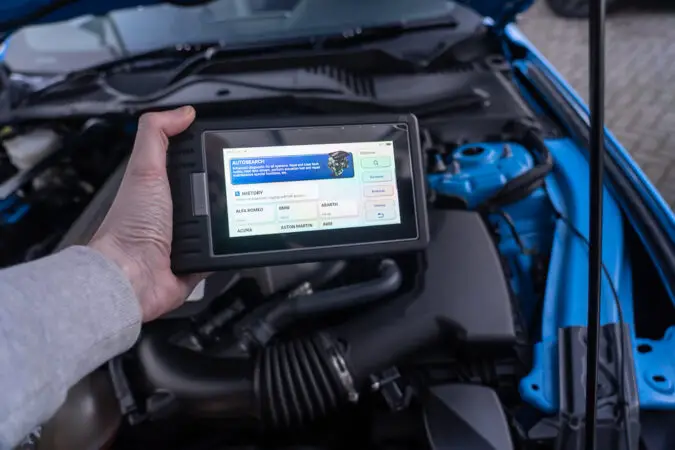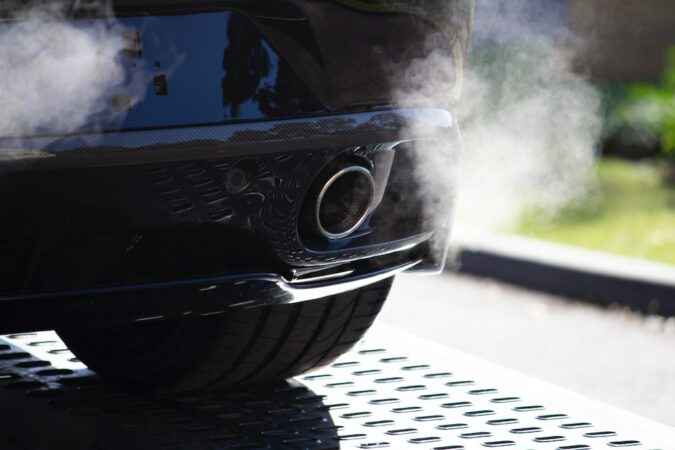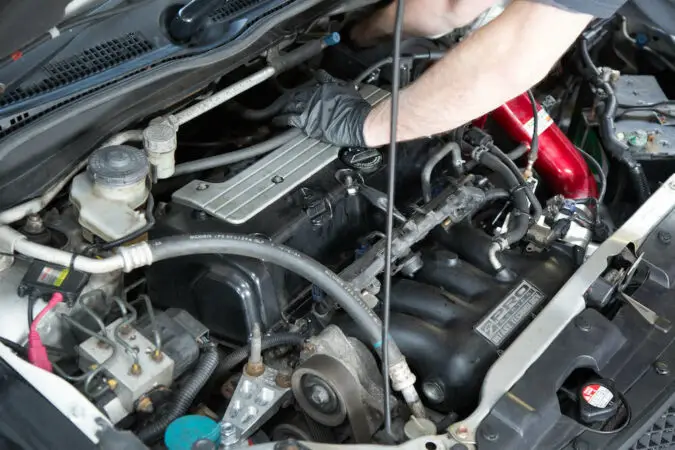Almost every car has a weak reliability point. No matter how good you take care of it, sometimes it’s just bound to appear in your car. Sometimes it’s due to age, other times it’s an engineering flaw or oversight during the design process. One such problem for Dodge cars is the P0456 code which is quite common for certain Dodge cars.
So, what does the P0456 code in Dodge cars mean? Read on to find out everything you need to know, and here’s our table of contents to help you navigate:
P0456 Dodge: What’s The Trouble?
Let’s get right into it, the P0456 is one of thousands of Diagnostics Trouble Code (DTC) that can appear in your Dodge. This code translates to: “Evaporative Emission System Small Leak Detected”.
Before we proceed, we’d like to note that this code means the same thing regardless of your car’s make and model. In other words, it’s a generic/universal code. As long as it has an OBD-2 system—which is every car since 1996—then this code applies to other car makes as well.
There are two kinds of trouble codes: generic/universal and manufacturer-specific. To determine whether it’s a generic code or not, take a look at the second digit of the code (the first number after the letter). If it’s a ‘0’ such as in this case, then it’s a generic code and it translates to the same thing regardless of the car brand.
Meanwhile, if the second digit is the number ‘1’, then this is a manufacturer-specific code. In this case, the code may mean different things across manufacturers. Keep in mind that it’s quite common for manufacturer-specific codes to mean the same thing with other car makes, but it’s a good idea to search what it means for your specific car make and model.
So, that’s the quick lesson on OBD trouble codes done. Let’s get back into that P0456 Dodge code:
P0456 Dodge: EVAP Issues Explained
The Evaporative Emission System or EVAP for short is one of several emissions control devices in your car (to learn more, check out our guide on what is the catalytic converter). Most cars since the ’80s are likely to have all six of these emissions control devices:
- Positive Crankcase Ventilation (PCV) system.
- Evaporative Emission Control (EVAP) system.
- Exhaust Gas Recirculation (EGR) system.
- A secondary air injection system
- Catalytic converter.
- Exhaust pipes.
Of course, we’ll focus on that EVAP system. Before we get into the causes and signs, here’s how the EVAP system works and what it’s for so you can get a better understanding:
How The EVAP System Works
The EVAP system is essentially a device that captures gas (fuel) vapors from the fuel tank. This device captures fuel vapors and prevents these toxic vapors from escaping into the environment. Hence why it’s considered a part of the emissions control system. Here’s how it works:
The video above should give you a good idea of how the system works. Here’s a recap: your Dodge (and other cars as well) have a vent in the fuel tank to let the vapors escape. This vent directs those vapors into a charcoal canister that captures and absorbs the fuel vapors.
Afterward, when the Engine Control Unit (ECU) demands it, it will open the purge valve. This valve will allow the vapor to escape from the charcoal canister. The engine will then draw these vapors and injects them into the engine’s cylinders to be used as fuel.
So, rather than letting these toxic vapors escape into the atmosphere, your car recaptures them and uses them to fuel the engine. After combustion, it turns into exhaust gases which will then be filtered by the car’s catalytic converter. The resulting gases are still not perfect, but it’s certainly less harmful to the environment than the fuel vapors.
Why Is The EVAP Necessary?
As mentioned, it’s necessary to control the emissions that a car produces. In the 1960s, smog resulting from car emissions was becoming a real problem. It was particularly bad in California, a state with a large population and where almost everyone drives.
Needless to say, smog is harmful to the environment and your health. To combat this problem, many emissions control devices started becoming mandatory. And California is often the first state to introduce laws mandating carmakers to fit their cars with certain emissions control devices, including the EVAP system in 1970.
So, it’s largely for environmental reasons. Cars without an EVAP system or other mandatory emissions devices will not pass DOT standards, let alone be allowed to go on sale in the US. And if you have a faulty EVAP system, chances are it won’t pass an emissions test.
Additionally, recirculating the fuel vapors helps to improve fuel consumption albeit slightly. This brings us to our next section:
P0456 Dodge Signs
Here are some signs that you might notice when you have a P0456 code in your car. Note that this applies to cars other than Dodge as well:
1. Poor Fuel Consumption
As mentioned, the EVAP system can help to improve fuel mileage in your car. This is because by using that recaptured fuel vapors, your car can reduce its fuel usage and use the vapors instead at certain times.
If you leak the EVAP, this means your car isn’t capturing as much fuel vapors as it normally would if at all. So, your car will be using less of that vapor, and use more fuel. However, the effect is likely minimal to the point where you might not notice it.
As far as we can tell, there has been no research done to tell how much the EVAP system affect MPG, so there’s no telling how much worse your fuel consumption will get worse. Unless your car has an MPG monitoring system, it’s unlikely you will notice the effect.
2. Fuel Smell
Perhaps the most likely sign you will notice is the smell of fuel inside the car. Since the leak would allow fuel vapors to escape into the open air, you’ll likely smell it while driving.
Regardless of the cause, the smell of fuel while driving is concerning. The best-case scenario is that it’s the fuel vapors escaping the fuel tank. The worst-case scenario is that you have a fuel leak somewhere and it could start a fire.
While less likely, fuel vapors can also start a fire in your car. Even if it’s not a fire hazard, inhaling fuel vapors is dangerous and can lead to serious health issues. It can cause headaches, dizziness, irritate your eyes and throat, and even death.
You’ll want to find out where the smell is coming from and address it. Best do it as soon as possible before your car turns crisper than burnt bacon—or worse. Some other possible causes of fuel smell while driving include a loose fuel tank cap, fuel line leaks (you’ll likely see fuel dripping down underneath your car), and loose fuel injectors.
That last one is particularly dangerous since the spark plug could ignite the fuel outside of the combustion chamber, starting a fire. Forget the check engine light, your engine will light up altogether. Jokes aside, we can’t stress this enough: do not ignore the smell of fuel inside your car.
3. Your Car Fails To Pass Emissions Test
Emissions test frequency varies by state. Some states require it every two years, others require it every year. Some states require it for every car, others will exempt cars than less three years old. We recommend checking with your local DMV office to find out when you need to do emissions testing for your car.
Anyway, since the EVAP system is part of the emissions control system, your car will likely fail an emissions test. Even if you don’t care about the environment, this means you’re going to have issues with registration. So, you’re going to want to address this issue.
P0456 Dodge: Causes And Diagnostics
The P0456 code tells you what’s wrong with the car, but it won’t tell you exactly what’s causing it. In this case, we know that there’s a leak in the EVAP system, but we’re going to have to find the source of that leak as well. Here are the potential causes:
- Loose gas cap. You might not have tightened the gas cap properly after your last fill-up, so check if the gas cap is loose. If it’s tight, then something else is triggering the code.
- Leaking or disconnected EVAP hose.
- Faulty or leaking purge canister or solenoid (control valve).
- Fuel tank leak. This is less likely but should be easy to check, locate the fuel tank underneath your car and inspect if there’s fuel leaking out of it.
So, those are the possible causes that can trigger the P0456 code. We’ll also discuss how to diagnose it, but there is one common culprit for the P0456 code in Dodge cars:
Common Cause For P0456 In Dodge
In the case of Dodge cars, the most common cause for the P0456 code is a faulty ESIM. The Evaporative System Integrity Module is a device that checks for leaks in the EVAP system. If there’s a leak, this device will detect it. However, it’s been known to fail in Dodge cars.
We’re not sure why it often fails. But it’s most likely some sort of engineering flaw or oversight during the design process of the device. This failure seems to affect mostly early 2000s Dodge cars, although later models are often affected as well. If you have a P0456 code in your Dodge, this is the most common culprit according to many owners.
The video above from BoostedMotorsports should give you a good idea of how to locate the device, remove it, and then replace it, especially if you have a Ram truck. In most cases, it’ll be underneath the car near the rear differential. Check your car’s service manual if you have difficulties locating the device.
After you remove the ESIM, you can test it out first to see if it’s faulty. Here’s what you need to do:
- Connect a multimeter to the electrical pins of the ESIM.
- Blow the ESIM through its valve, and inspect the multimeter’s reading.
- It should read about 12 volts, if there’s no reading or it’s really low, then you have a faulty ESIM.
This is the most common culprit for EVAP-related codes in Dodge cars. It seems to be a badly-designed and unreliable product, so we recommend checking the ESIM first. If the ESIM is fine, here’s how to diagnose the rest of the EVAP system:
Step 1 – Check For Other Trouble Codes
The trouble codes won’t tell you exactly what’s wrong with the car, but they can help narrow things done and make the diagnostics process easier. We recommend scanning the OBD system with an OBD reader and seeing if any other codes are present, which can help you to narrow down the problem.
For example, the P0445 code is another EVAP-related code. However, this code usually indicates an issue with the purge control valve, although it may also be there because of a loose gas cap. Anyway, if you see this code as well, then that narrows down your leak issue with the purge control valve and that’s what you should inspect next.
If no other codes are present, then it’s time to do a visual inspection:
Step 2 – Visual Inspection
Inspect all the EVAP system components and hoses and see if you can find any physical leaks. This includes inspecting the hoses, the purge canister, the valves, and checking your fuel tank for leaks as well since that can also trigger the P0456.
The video above from 1A Auto is a great guide on how to check for physical leaks on the EVAP system. Of course, the location of the components will vary depending on your car’s make and model. If you have difficulty locating the components, check your car’s service manual.
Some components may not show signs of damage, such as the purge control valve. In this case, you need to test the device:
Step 3 – Testing The Purge Control Valve
Testing this device is fairly straightforward:
- Locate and remove the purge control valve. This is usually a black plastic device that sits near the car’s air intake hoses. Check your service manual to help locate the device.
- The car has to be off when you remove it. Disconnect its electrical connectors, then undo the bolts holding it down and remove the device.
- Blow into the valves of the device. If air goes through the other end, then your purge valve is stuck open which causes a leak in the system.
Finally, if all the components seem fine, you can do a smoke test to help you detect the leak. Sometimes the leak is so small that you can’t see it, and a smoke test will help you detect the leak.
Step 4 – Smoke Test
Note that this test will require a smoke machine. They can cost thousands of dollars, and it’s not something that your local auto parts store is likely to have to rent. So, unless you already own one or you have access to one, you’re going to have to ask an auto repair shop to do it for you. That being said, here’s how to perform the test:
By paying attention to where the smoke comes out, you can detect where the leak is happening. If it turns out no smoke is coming out from the system, there are two possibilities: the EMIS or the purge control valve is faulty. It’s likely the electrical connections have failed, and they’re not working properly.
If you’re having difficulties finding the issue, or you can’t do a smoke test at home, we recommend taking your car to the dealer or a trusted repair shop for a diagnosis. They will usually charge you around $150 on average to diagnose an EVAP problem.
P0456 Dodge Repairs & Cost
Hopefully, the steps above have helped you how to diagnose and find the cause of the P0456 code in your Dodge. Now, here are the repair costs:
- Gas cap replacement. If you have a bad gas cap, replacing it may fix the issue. This costs up to $60 in most cars.
- EVAP Purge Control Valve replacement. This costs anywhere between $140 – $200 for most cars including labor. You can replace them on your own, and the parts itself is usually around $50. We found one example for a 5.7L Hemi V8 that costs $46.95.
- Charcoal Canister Vent Control Valve. This costs between $80 and $200 depending on the car’s make and model including labor. The part itself usually costs no more than $120.
- Charcoal Canister replacement. The charcoal canister itself might be bad, in which case you’ll need to replace it. It costs between $200 – $600, but we found that in the Dodge Challenger it’s estimated to cost no more than $239 (especially among the best Dodge Challenger years).
- Replace EVAP line and hoses. Replacing the EVAP system’s hoses usually cost no more than $100 including labor, as the hoses and lines themselves are not very expensive, to begin with. But it may be more than depending on how many lines you need to replace.
On average, you can expect to pay somewhere between $150 – $300 to repair a P0456 code. The most expensive job is usually replacing the charcoal canister. But as mentioned, according to YourMechanic the Dodge Challenger costs $239 on average to replace the canister. So it’s still relatively affordable.
Most of the replacement jobs are relatively easy, and you can do it yourself to save some money. But if you’re not sure about your skills or you have butterfingers, better leave it to professionals to avoid any further damages or issues.
Facts about P0456 Code – Evaporative Emissions System Small Leak Detected:
- P0456 is an OBD-II generic code that indicates the ECM has detected a very small leak in the evaporative system during vehicle off-testing.
- The test has to fail twice in a row to cause the code to be activated by the ECM.
- The cause of code P0456 can be a small leak at any of the system components or hose connections.
- The two most common causes of the code are the gas cap vent and the purge vent valve, which will not seal completely.
- Symptoms of the P0456 code include the Check Engine Light illuminating and the code being set in ECM memory.
- To diagnose the P0456 code, a mechanic will scan codes, inspect the entire vapor purge valve system, check the purge control valve, and perform a smoke leakage test on the fuel vapor system.
- Common mistakes when diagnosing the P0456 code include assuming the purge control valve is defective without doing a thorough diagnostic of the complete system and not verifying the leak and replacing parts that may or may not be the problem.
- The P0456 code can cause the Check Engine Light to go on, which will cause a failed emission test.
- The code means the fuel vapor system has a very small leak, and the ECM monitors will not pass emissions if the leak is not found.
- Repairs that can fix the P0456 code include replacing a leaking gas cap, replacing the leaking or clogged purge vent valve, and replacing a leaking purge valve.
P0456 FAQ
Got any more questions about the P0456 code in your car? Here are some answers that might be helpful:
What Is P0456 In Dodge Ram 1500
The P0456 in the Dodge Ram 1500 indicates a small leak in the car’s Evaporative Emission Control (EVAP) system. This is a generic code, so it means the same in any Dodge cars or any cars from other carmakers. The EVAP system itself is an emissions control device that captures fuel vapors from the fuel tank. It uses the vapor to power the car’s engine and prevents it from going into the open air and harming the environment.
Is It OK To Drive With P0456 Code
This code means your car is expelling toxic fuel vapors into the atmosphere, which isn’t good for the environment. You can probably still drive the car, but we would advise addressing the issue as soon as possible before it leads to further issues. If you don’t care about the environment, remember that this code can also mean that there’s a minor fuel leak. While unlikely, it’s still a fire hazard so it’s best to not ignore the P0456 code.
How Do I Fix P0456 Code In Dodge
The P0456 code may appear simply because of a loose gas cap. Check if your gas cap is tight, and if it’s broken, then you’ll need to replace it which usually costs no more than $60 for most cars. If the gas cap is fine, then one or more of the EVAP components is faulty or is leaking. Replacing the leaking or faulty component will resolve the issue. This can cost up to $600, but in Dodge cars, it costs around $240 on average.
P0456 Dodge: Wrap Up
To summarize, the P0456 is a generic trouble code that means there’s a small leak in the car’s Evaporative Emissions Control system, or EVAP for short. Since this is a generic/universal code, it means the same thing regardless of your car’s make and model. So, this is the same whether you have a Dodge, Ford, Toyota, or any other car brand.
In Dodge cars, the most common cause is a faulty Emission System Integration Module (ESIM). This is the device that monitors the EVAP system for leaks, and many Dodge owners have complained that this device often fails. Kind of ironic that the device that’s supposed to monitor leaks is the cause for the leak trouble code, no?
Anyway, if you have a P0456 code in your Dodge, we recommend checking the ESIM first. If it seems fine, then check for physical leaks and test the purge control valve, as that’s usually the second most common cause. If you’re stumped, do a smoke test to help find small leaks.
After you find the cause, replace the faulty parts to get rid of the check engine light and to make sure your car is working fine. The P0456 code usually doesn’t affect driveability, but can turn into serious problems if ignored.
The most expensive EVAP repair is replacing the charcoal canister, which can cost up to $600. But as mentioned, this is usually somewhere around $239 for Dodge cars. In any case, we hope this article has been helpful for you, and good luck in getting rid of that P0456 code!





